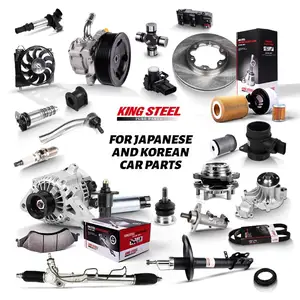(293029 products available)














































































































































































Japan part refer to various components and accessories used in vehicles manufactured in Japan. These vehicles, known for their reliability and fuel efficiency, have become popular worldwide, leading to a steady demand for both original equipment manufacturer (OEM) and aftermarket parts.
Engine Components:
Japan cars parts manufacturers produce a wide range of engine components. These include cylinder heads, pistons, timing belts, and water pumps. Each part is designed to enhance the engine's performance and improve the vehicle's power output.
Electrics:
Japan electric parts are known for their durability and efficiency. They include starters, alternators, and various sensors such as mass airflow sensors and oxygen sensors. The sensors play a crucial role in monitoring different parameters in the vehicle to ensure optimal performance.
Chassis and Suspension:
Chassis parts provide the foundation for the vehicle's body, ensuring stability and support. They include Japan car chassis parts such as subframes, chassis braces, and bushings. Other suspension parts include coilovers, shock absorbers, struts, and sway bars. All these suspension components work together to provide a smooth and comfortable ride.
Body Parts:
Body components include bumpers, hoods, fenders, hatches, and side skirts. They are designed to enhance the exterior look of a vehicle. For instance, Japan side skirts are popular among car owners looking to lower their vehicles and improve aerodynamics.
Transmission Parts:
Transmission components include Japan manual shift knobs, clutch pedals, and flywheels. The transmission system is made up of a complex network of components that work together to transfer power from the engine to the wheels, enabling the vehicle to move.
Braking Components:
Braking components include brake pads, brake discs, and brake calipers. They are essential for slowing down and stopping the vehicle, ensuring the safety of the driver and passengers.
Interior and Exterior Accessories:
Interior accessories include Japan car seat covers, floor mats, door panels, and headliners. Exterior accessories include spoilers, decals, and light covers that enhance a vehicle's aesthetics.
Specifications of Japan parts vary depending on the type of vehicle and the specific component in question. However, there are some general specifications to look out for:
Quality and Durability
Japan parts are manufactured to meet stringent quality standards. They are durable and sturdy, making them suitable for everyday use.
Compatibility and Fitment
Japan parts are designed to fit Japanese vehicles precisely. They are compatible with the specifications and requirements of the vehicles.
Quality Control
Japan parts undergo rigorous quality control processes at every stage of production. From raw material sourcing to final product inspection, quality is continuously monitored and maintained.
Performance Standards
Japan parts are subject to standardized performance criteria. Components such as engines, transmissions, and suspensions are tested to ensure they meet established performance benchmarks.
Safety Standards
Japan parts must comply with Japanese safety regulations. These regulations address aspects such as crashworthiness, emissions control, and pedestrian safety.
Maintenance of Japan parts is crucial to ensure optimal performance and extend their lifespan. Here are some general guidelines:
Regular Inspections
Car Japan parts should be inspected regularly to identify potential problems. Look for signs of wear, damage, or leakage. Early detection can prevent further damage and reduce repair costs.
Regular Oil Changes
Regular oil changes are essential for maintaining engine health. Fresh oil lubricates engine components, reducing friction and wear. Follow the recommended oil change interval in the owner's manual.
Air Filter Replacement
The air filter prevents debris and dirt from entering the engine. A clogged air filter restricts airflow, affecting engine performance. Replace the air filter as recommended.
Tire Maintenance
Tires are vital for vehicle safety and performance. Maintain proper tire pressure, regularly inspect for wear and replace tires when needed.
Brake System Inspection
The brake system is critical for vehicle safety. Regularly inspect brake pads, discs, and calipers. Replace worn components promptly to ensure effective braking performance.
Suspension and Steering
Japan spare parts vehicles use a suspension system to provide a smooth ride and good handling. Regularly check shock absorbers, springs, and other suspension components.
When sourcing Japanese parts of vehicles, buyers should consider several factors to ensure they make an informed purchase. The requirements of the target market are the first thing buyers should think about. Do they want performance parts for a sports car or replacement parts for a daily commuter vehicle? By knowing the needs of the target market, buyers can stock up on parts that will sell fast.
The condition of the vehicle parts is another crucial factor to consider. While buyers can find used parts in good condition, they should also check the wear and tear levels of refurbished and remanufactured parts. Additionally, they need to source from suppliers offering grade A parts to prevent selling products that will disappoint customers.
Compatibility is another crucial factor to consider when buying Japanese car parts. Not all vehicles use the same spare parts. Buyers should ensure they are getting parts that will fit into the cars properly, reducing the risk of malfunction. To confirm compatibility, they can check part numbers, car models, and manufacturing years.
Quality is non-negotiable when sourcing any kind of product. Unfortunately, it can be difficult to differentiate between good and bad quality just by looking at the products. To be on the safe side, buyers should get products from reputable suppliers and brands. They can also read reviews and feedback from previous customers to get a feel of the quality they can expect.
Furthermore, buyers should investigate the warranty and after-sales support the supplier offers. In case of defects, could the supplier replace the goods? What kind of support could the buyer expect from the supplier? By answering these questions, buyers can choose a reliable supplier and get parts with generous warranties.
Moreover, buyers should take time to compare the prices of different suppliers before settling for one. The goal is to get a good deal and add value to the business. However, they should avoid offers that are too good to be true, as they could indicate inferior quality.
Here is a step-by-step guide on how to replace a car part:
Select the part to be replaced
Identify which part of the car that needs to be replaced. This could be any external or internal part of the car.
Get the right tools
Get the necessary tools that will help replace the part. This could be a screwdriver, wrench set, pliers, or hex key, depending on the part that is going to be replaced.
Prepare the new part
Get the new part that is going to be replaced and make sure it is compatible with the old part that is going to be replaced.
Remove the old part
Use the necessary tools to remove the old part from the car. Make sure to be careful while removing it so that other parts of the car are not damaged.
Install the new part
Align the new part with the mounting points and carefully attach it. Ensure it fits properly and is aligned correctly.
Test the new part
Check if the new part is functioning well. If it is a mechanical part, ensure it operates smoothly. If it is an electrical part, ensure it receives power and functions as expected.
Dispose of the old part
Dispose of the old part properly. Check with local regulations for disposing of automotive parts. Some parts may need to be recycled.
Q1: Do Japanese car parts have warranties?
A1: Yes, Japanese car parts have warranties. The warranty coverage and duration may differ depending on the type of part, the manufacturer, and the supplier. Wholesale buyers should inquire about the warranty information from the suppliers they intend to source the parts from.
Q2: How can someone ensure they are buying genuine Japanese car parts?
A2: To ensure the car parts are genuine, buyers should purchase them from authorized suppliers and dealers. They can also check for certification logos and the physical appearance of the parts to ensure they are correct.
Q3: Are all Japanese car parts compatible with every Japanese car?
A3: No, not all Japanese car parts are compatible with every Japanese car. Some parts are designed to suit specific car models. To ensure compatibility, buyers should specify the car model and type when ordering the parts.
Q4: Can the customers who order Japan parts from Chovm.com get help in case of any technical issues?
A4: Yes, they can get help in case of any technical issues. Most suppliers offer technical support services to their customers. Additionally, buyers can join various communities online to get more help and support regarding the parts they have purchased.